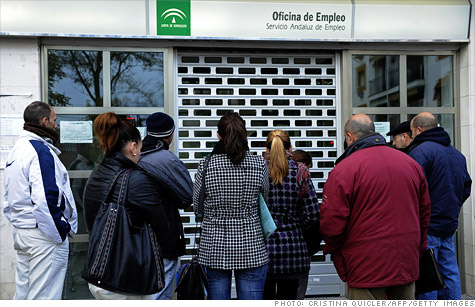
People wait in line in front of a government employment office in a suburb of Seville, Spain. Despite sovereign debt worries and unemployment raising to 10.9% in the eurozone, the EU and eurozone avoided falling into recession in the first quarter.
NEW YORK (CNNMoney) -- Stronger-than-expected growth in Germany was enough to help the European Union and the 17-nation eurozone avoid falling into recession for the second time since 2009 during the first three months of this year.
Initial readings on gross domestic product, the broadest measure of an economy's health, released Tuesday showed Germany's economy grew 0.5% in the first quarter, an improvement from the decline of 0.2% at the end of 2011.
The forecast had been for growth of only 0.1% for Germany, the continent's largest economy, and there were some fears that it could report a drop in GDP for the second straight quarter, the common definition of an economy in recession.
The growth in Germany was enough to have GDP in the 27-nation EU and the 17-nation eurozone that uses the common currency both remain unchanged compared to the previous quarter, following a 0.3% decline on that basis at the end of last year. Economists had forecast that both would fall into recession with another quarter of falling GDP.
The relative weakness in Europe's economies is blamed on worries about sovereign debt crisis, which is forcing some nations into austerity programs of deep cuts in government spending or increased taxes in order to close budget gaps and pay their debt obligations. Even some of the stronger economies are going through their own austerity programs.
European banks worried about their holdings of the debt are cutting back on lending, and consumers and businesses are being forced by conditions to cut back on spending as well. Eurozone unemployment has hit a record 10.9% at the same time unemployment is falling steadily in the United States.
Julian Callow, economist with Barclays Capital, said the threat of a recession hitting the EU or eurozone has not yet passed. He said they only barely avoided a downturn in this initial reading, adding that second-quarter readings show signs of further slowing. The austerity programs in different nations are likely to also cause further slowing.
But Callow said Tuesday's reading also shows there is more strength than previously expected in several markets. It's possible that Greece, the nation facing the most serious sovereign debt crisis, could even end up with a positive first-quarter GDP when its reading is eventually reported.
"There are some encouraging signs that come out of this. For once, it's a little bit on the upside of expectations," he said.
There are 11 countries in the EU that are now judged to be in recession, although some, including Greece, have yet to report first-quarter results. One nation previously judged to be in recession, Belgium, came out of its downturn with 0.3% first quarter growth reported Tuesday.
Some other troubled economies reported further pain. Italy, the continent's fourth- largest economy, had GDP fall 0.8% in the quarter, a bit worse than forecasts and wider than the 0.7% decline in fourth quarter.
There are few areas of true economic strength in Europe at the current time -- only Latvia and Finland, both relatively small economies, reported growth of over 1%.
The problems in Europe are blamed for some of the slower growth being reported elsewhere in the world. U.S. GDP slowed to a 2.2% annual rate of growth in the first quarter from a 3% growth rate at the end of last year. The U.S. GDP works out to a 0.5% increase the previous quarter, the basis on which European GDP is reported.
Chinese GDP came in at an annual growth rate of 8.1% in the first quarter, but that was down from 8.9%. That represents a 1.8% increase over the previous quarter.
Europe is the largest market for Chinese exports. Subsequent readings have showed industrial production, spending and other key economic readings slowing there, raising fears of a so-called hard landing for the fast-growing economy. ![]()
| Overnight Avg Rate | Latest | Change | Last Week |
|---|---|---|---|
| 30 yr fixed | 3.80% | 3.88% | |
| 15 yr fixed | 3.20% | 3.23% | |
| 5/1 ARM | 3.84% | 3.88% | |
| 30 yr refi | 3.82% | 3.93% | |
| 15 yr refi | 3.20% | 3.23% |
Today's featured rates:
| Latest Report | Next Update |
|---|---|
| Home prices | Aug 28 |
| Consumer confidence | Aug 28 |
| GDP | Aug 29 |
| Manufacturing (ISM) | Sept 4 |
| Jobs | Sept 7 |
| Inflation (CPI) | Sept 14 |
| Retail sales | Sept 14 |